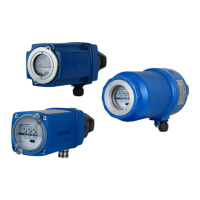8 | Flame monitor settings
D-LX 201/721
83
NOTICE
The flame monitors (including the Ex versions and all associated components) are
devices with type approvals.
Any changes to to devices with type approvals will lead to the loss of the approval.
Repairs must only be performed by the manufacturer or persons that it has authorised
to do so. This is the only way of ensuring responsible compliance with the
specifications for the type approval of the certifying body.
For safety reasons, flame monitor setting adjustments must only be carried out by ap-
propriately trained personnel.
DURAG offers appropriate courses in this regard.
Switch positions 1 to 4 (for the FFDT) of the DIP switches S3 and S4 (see Fig.8.6 in
section 8.4 Setting the threshold for the flicker frequency [}77] and the table
Table8.1) must
not be changed under any circumstances
when setting the switching
thresholds for the frequency. The switch positions for the FFDT on the type label can
be found in the following table for control purposes:
You can set different FFDTs for ranges A and B:
FFDT Range A Range B
DIP position* 1 2 3 4
1 sec off off off off
2 sec on off on off
3 sec off on off on
5 sec on on on on
Table8.2: Switch position of MODE switches S3 and S4 (FFDT)
* The DIP positions 1 to 4 must be set according to the FFDT on the type label! The
FFDT set must be visible from outside!
To avoid an error shutdown, set the MODE switches S3 and S4 to the same setting
within 8 secs.
NOTICE
When re-attaching the cover, make sure that the printed circuit boards slide into the
guide rails correctly and that the connecting lines are not squeezed.
Standard housing:
The seal between the cover and the middle part must fit fully within the middle part.
Tighten the long screws to attach the cover, so that the cover is flushly in position all
the way round the middle part. (max. torque 0.7 Nm).
Ex-housing
For information on closing the housing, see section 7.4.6 Closing housing M4 and S2
(for zone 1/21) [}60]

